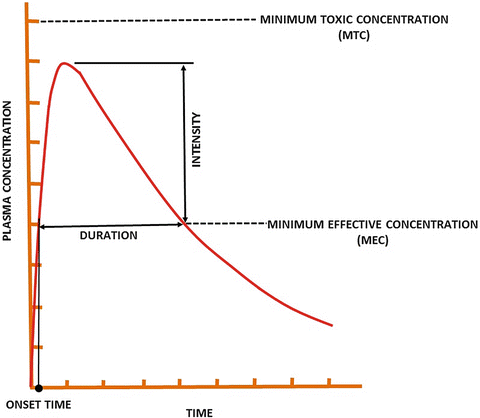Fig. 2.1
Schematic diagram showing the various pharmacokinetic processes following administration of a drug. D drug, P protein, R receptor
How Pharmacokinetics Influence the Clinical Effect of a Drug
Pharmacokinetic processes, i.e., absorption, distribution, metabolism and excretion (ADME) determine how rapidly (hence, its speed of onset), in what concentration (hence, its intensity of effect), and for how long (hence, its duration of action) a drug will appear at its target tissues (Fig. 2.2).


Fig. 2.2
Plasma concentration-time curve showing the onset time, duration of action and intensity of effects
Drug Administration
For a drug to be able to produce its intended clinical effects, it must first be able to reach its target site of action in the body at an effective concentration. If the drug is to act on some external surfaces, e.g., skin, ears or eyes, it may be applied directly on the affected surface. However, if the drug is meant to produce an effect inside the body, whether it be widespread (e.g., systemic antibiotics) or on some specific tissues (e.g., anti-thyroid agents), then the drug must be administered in such a way that it is able to get into the systemic circulation and be transported to the site(s) where the deranged body function is to be rectified.
How Drugs Are Administered
Drugs can be administered by a wide variety of routes. These may be generally divided into enteral routes (e.g., sublingual, oral, and rectal), parenteral injections (e.g., subcutaneous, intramuscular, and intravenous), inhalation, topical, transdermal and intranasal. Certain special routes may be used to provide better therapeutic outcomes: intra-arterial route in cancer chemotherapy and intrathecal route for central nervous system infections or for spinal anesthesia. These routes are much more hazardous and would obviously require greater skills and care in administering the drug.
Which Route of Administration
When making decision on the route of administration, two major factors come to mind: therapeutic concerns and drug properties. The therapeutic concerns include questions relating to the desired onset rate and duration of drug action, where the drug target site is (readily accessible or not) and whether or not patient compliance is an issue. The drug properties to be taken into account include its physicochemical characteristics (e.g., lipid solubility, molecular size, ionization status) and plasma concentration-time profile. The advantages and disadvantages of some of the common routes of administering drugs are given in Table 2.1.
Table 2.1




Advantages and disadvantages of some common routes of drug administration
Stay updated, free articles. Join our Telegram channel

Full access? Get Clinical Tree


